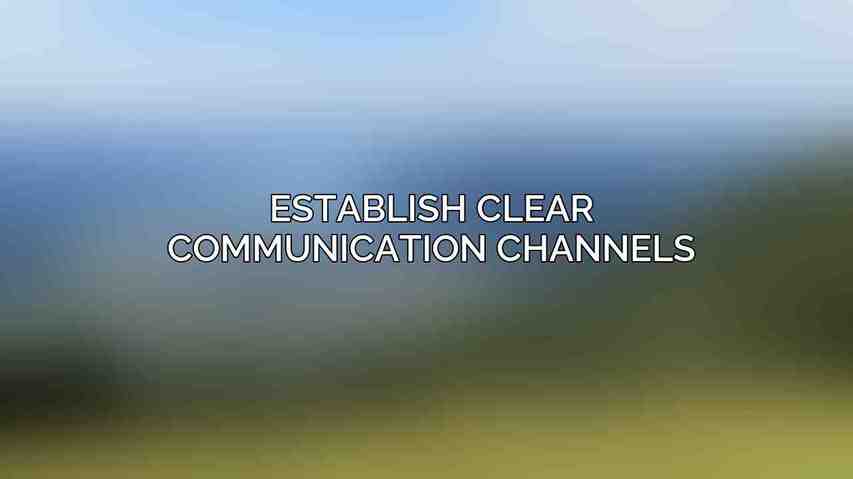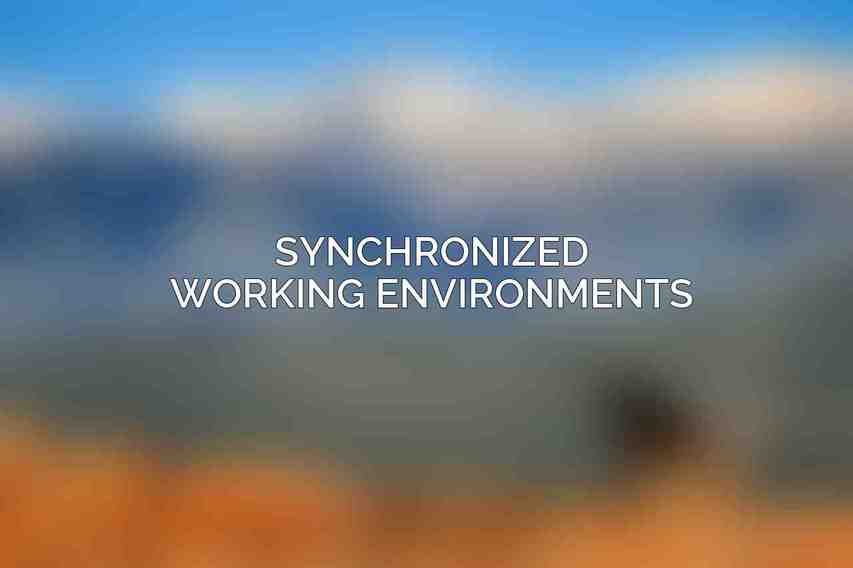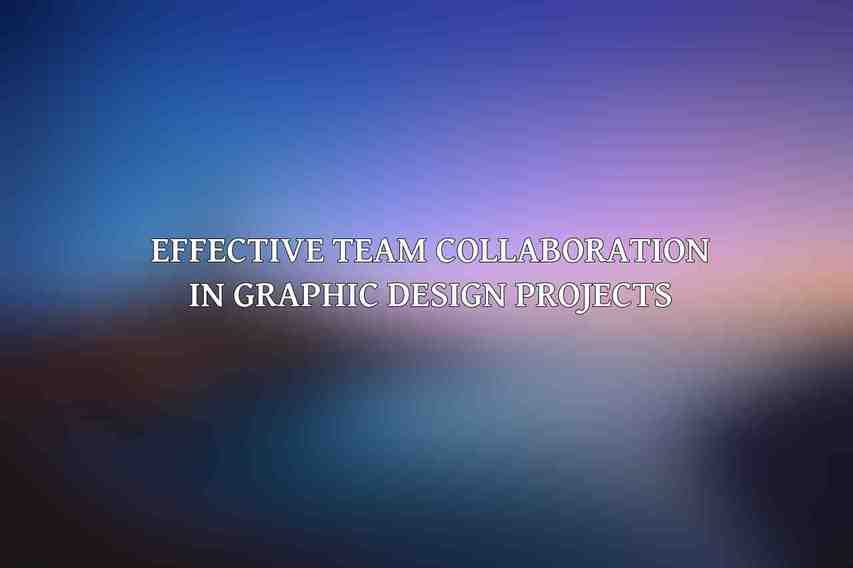Effective communication is crucial for the success of any collaborative project, especially in graphic design where clarity and understanding are paramount. Utilizing a variety of communication channels can streamline workflows and enhance team productivity. Establishing clear communication channels is the first step towards efficient team collaboration.
Establish Clear Communication Channels

Utilize a dedicated project management platform: Platforms like Asana, Trello, and Basecamp offer a centralized space for task assignment, progress tracking, and communication among team members.
Leverage instant messaging tools: Tools such as Slack, Discord, and Microsoft Teams facilitate real-time communication, quick updates, and informal discussions within the team.
Hold regular team meetings: Scheduling regular meetings helps in setting project direction, addressing concerns, and fostering team cohesion. Setting clear agendas, encouraging participation, and utilizing video conferencing for remote teams can enhance the effectiveness of these meetings.
Establishing these channels not only ensures the smooth flow of information but also encourages transparency and collaboration among team members.
Shared Libraries and Resources
In graphic design projects, maintaining a shared repository of resources and design elements is essential for consistency and efficiency. Creating and maintaining a centralized file repository is vital for seamless collaboration and easy access to project assets.
Create and Maintain a Centralized File Repository
Use cloud-based storage services: Cloud storage services like Google Drive, Dropbox, and *OneDrive provide a secure and easily accessible platform for storing and sharing design files.
Establish a naming convention for files: Consistent file naming conventions help in organizing files, avoiding confusion, and enabling quick search and retrieval of assets.
Regularly update and organize files: Continuously updating and organizing files ensures that team members have access to the latest versions of documents and resources, promoting efficient collaboration.
By centralizing resources and maintaining organized libraries, team members can work cohesively and access necessary assets without disruptions.
Synchronized Working Environments

Creating synchronized working environments is essential for ensuring that all team members are aligned and working towards common project goals. Establishing version control systems and utilizing task management tools can enhance productivity and streamline project progression.
Establish Version Control Systems
Implement a version control tool: Tools like Git, Subversion, and *Mercurial help track changes, maintain a history of revisions, and facilitate collaboration among team members while avoiding conflicts in design files.
Track changes and maintain a history of revisions: By tracking changes and maintaining a history of revisions, team members can revert to previous versions if needed, ensuring the integrity of the design work.
Facilitate branching and merging for parallel development: Enabling branching and merging in version control systems allows team members to work on different aspects of the project simultaneously, streamlining collaborative efforts.
By establishing synchronized environments through version control and task management tools, teams can effectively manage workflows and ensure project coherence.
Overcoming Challenges in Collaborative Graphic Design
Collaborative graphic design projects often come with challenges that require proactive measures to address. Overcoming challenges such as differences in design styles, managing time zones, and fostering inclusion and diversity are crucial for maintaining team harmony and project success.
Address Differences in Design Styles
Encourage open communication and constructive criticism: Creating a culture where team members feel comfortable sharing feedback and ideas contributes to the growth and improvement of design work.
Establish design principles and guidelines: Setting clear design principles and guidelines helps align team members’ design approaches, ensuring consistency and coherence in the project.
Provide design briefs with clear objectives: Clear design briefs with defined objectives help team members understand project requirements and align their creative efforts towards a common goal.
By addressing and embracing diverse design styles, teams can leverage individual strengths and perspectives to create innovative and impactful visual solutions.
Manage Time Zones and Availability
Establish flexible work schedules: Instituting flexible work schedules accommodates team members in different time zones, promoting work-life balance and ensuring collaboration across geographical boundaries.
Utilize scheduling tools to coordinate availability: Utilizing scheduling tools helps in coordinating meetings, deadlines, and project milestones among team members in varying time zones, enhancing communication and project efficiency.
Leverage asynchronous communication channels: Using asynchronous communication channels like email and project management platforms accommodates team members’ availability and facilitates continuous progress, even during non-overlapping work hours.
By managing time zone differences effectively, teams can maintain productivity, ensure continuous progress, and capitalize on diverse perspectives.
Foster Inclusion and Diversity
Promote a welcoming and inclusive environment: Cultivating a culture of inclusivity and respect fosters creativity, collaboration, and mutual understanding among team members from diverse backgrounds.
Seek input and perspectives from diverse team members: Encouraging participation and valuing diverse perspectives enriches the creative process and leads to innovative solutions in graphic design projects.
Establish policies against discrimination and bias: Implementing clear policies against discrimination and bias creates a safe and equitable work environment, where all team members feel valued and respected.
By fostering inclusion and diversity, teams can harness the full potential of their members, leading to enriched creative outputs and a more harmonious working atmosphere.
effective team collaboration in graphic design projects hinges on robust communication strategies, shared resources, synchronized working environments, and proactive measures to overcome challenges. By implementing these strategies and fostering a culture of collaboration and inclusivity, graphic design teams can elevate their creative output, achieve project success, and nurture a harmonious work environment.
Frequently Asked Questions
What are the benefits of effective team collaboration in graphic design projects?
Effective team collaboration in graphic design projects helps in sharing ideas, improving creativity, enhancing efficiency, and ensures timely completion of projects.
How can team members effectively communicate and share ideas in graphic design projects?
Team members can effectively communicate and share ideas in graphic design projects by using collaborative tools, holding regular meetings, providing feedback, and maintaining open communication channels.
What strategies can be implemented to enhance team collaboration in graphic design projects?
Some strategies to enhance team collaboration in graphic design projects include setting clear goals, assigning roles and responsibilities, establishing a feedback loop, and fostering a culture of trust and respect among team members.
How can conflicts be resolved among team members in graphic design projects?
Conflicts among team members in graphic design projects can be resolved through open communication, active listening, finding common ground, seeking consensus, and involving a neutral mediator if needed.
Why is it important to foster a collaborative team environment in graphic design projects?
Fostering a collaborative team environment in graphic design projects is important because it leads to improved creativity, increased productivity, better problem-solving, and overall project success.
